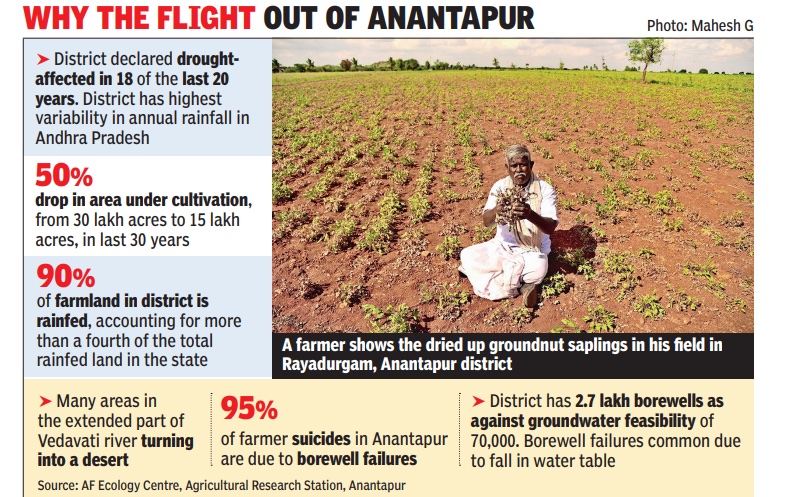Anantapur district
This is a collection of articles archived for the excellence of their content. Additional information may please be sent as messages to the Facebook community, Indpaedia.com. All information used will be gratefully acknowledged in your name.
This is a collection of articles archived for the excellence of their content. |
=Droughts=
2000-20
Ujwal Bommakanti, Oct 31, 2021: The Times of India

From: Ujwal Bommakanti, Oct 31, 2021: The Times of India
In Andhra Pradesh, 2 decades of drought emptying out ‘blessed’ district
Anantapur in Telugu means “blessed with many things”. It's an ironic name for a place that has come to be known for what it’s not blessed with — rainfall.
This district in Andhra Pradesh has seen 18 droughts in the last 20 years (till 2020), making it a living example of creeping desertification and mass migration.
Situated in the bowels of the rain-shadow region of Rayalaseema, Anantapur is the driest district in south India. Met records since 1882 show Anantapur has long been notorious for droughts and water distress. But recent decades have been particularly severe.
In the last 30 years, the cultivated area in the district has dropped by 50%, from 30 lakh acres to roughly 15 lakh acres, as the drought pattern changed from once every three years to almost every year. Even though as per IMD data the district received deficient or scanty annual rainfall on 10 of the 20 years since 2000, the government declared Anantapur drought-affected in 18 of these years as rains were unevenly distributed within the district.
An IMD paper on rainfall trends in Andhra Pradesh from 1989 to 2018 shows Anantapur had the state’s highest rainfall variability of 76%, although the amount of rain over these decades had not significantly changed.
“Such variability means Anantapur has a high probability of drought or floods in any given year,” said IMD’s Pulak Guhathakurta, one of the authors of the study.
With 90% of agriculture in the district being rainfed, the vagaries of the weather has made farming increasingly unviable. In the last 26 years, standing crop in the district has failed in at least 15 years because of drought and thrice due to excess rainfall, according to B Sahadeva Reddy, chief scientist at the Anantapur Research Station.
Many landowners have handed over their farmlands to tenant cultivators for free. Those who collect tenancy fees get only between Rs 500 and Rs 1,000 per acre — a pittance compared to Rs 25,000 to Rs 30,000 per acre in other districts.
Y V Malla Reddy, director of Accion Fraterna Ecology Centre based in Anantapur, estimates that around four to six lakh workers have migrated out, many heading to Bengaluru, Hyderabad and Kerala. “Most of them have set up shelters in Bengaluru and work there. They visit their families, if they had left them in native villages, only during festivals like Sankranti and Ugadi. A lot of them were land-owning farmers who sold their lands to pay mounting debts, and turned to manual labour,” Malla Reddy told TOI.
Many women who migrated from Anantapur have entered the flesh trade. In Kadiri assembly constituency, around 1,600 women and minor girls have been identified as victims of trafficking. They were forced to take up sex work in Mumbai and even in gulf countries such as Kuwait and UAE, according to the NGOs in the district. Trafficking cases in Anantapur stand at 14,000, as per police records in the last 20 years.
A major shift away from traditional crops to groundnut in the 1990s made matters worse. The monocropping was a blow to local biodiversity and farmers began felling trees as groundnut cultivation demands lots of sunshine. Anantapur now has vast stretches of land turning sandy, a phenomenon called desertification, and unfit for cultivation.
Gummagatta mandal in Rayadurg assembly constituency is a classic case of climate triggered migration. About 40% of Gummagatta’s population has left, mostly to Bengaluru for construction work. The mandal, once recognised for a variety of crops, is now better known for its specialised labour force. Gonabavi village here is almost barren with no crops being grown. Nearly all farmers are now migrant labour with expertise in digging earth and repairing underground cables.
Residents of Kalugodu village of Rayadurg mandal make a living by erecting scaffoldings for high-rise building constructions. It’s a risky job, and not surprisingly, the village has many widows and physically challenged men. Thalari Rajini, 25, lost her husband Ramanji (32) after he fell from the top of a building in Bengaluru on February 22, 2019. The day he died, Rajini gave birth to a second child, a daughter. Rajini is not eligible for a widow pension as her mother-in-law, listed in the same ration card, is already a beneficiary.
“I received only Rs 2 lakh out of Rs 5 lakh from the Chandranna Bheema scheme because of the change in government,” Rajini told TOI. Another widow, Rajamma (50), lost her husband and a son in similar mishaps in Bengaluru. Her youngest son Suresh (23), who also worked in Bengaluru, is now physically challenged after falling from a scaffolding in 2020. The families of Rajini and Rajamma owned five acres of land each a decade ago. The lands were sold off to pay for debts.
Many seasonal migrants return to claim their National Rural Employment Guarantee Act, 2005 (NREGA) benefit for 100 days every year. “A significant number of people have returned to Anantapur during the Covid-19 pandemic. The district tops in the state for most NREGA funds being disbursed. We have given extra money that the central government gave in view of Covid-19 as well. We are trying to provide jobs to them in other ways as well by promoting multi-crop cultivation,” district collector S Naga Lakshmi said.